How to Store Salt Long-Term & 9 Rational Reasons You Should
Do you have a stockpile of salt? If not, you might want to consider stocking up. Salt is an essential item for preppers and can be used for many purposes. But do you know how to store salt long-term? In this blog post, we’ll discuss the best way to store salt so that it is effective when you need it.
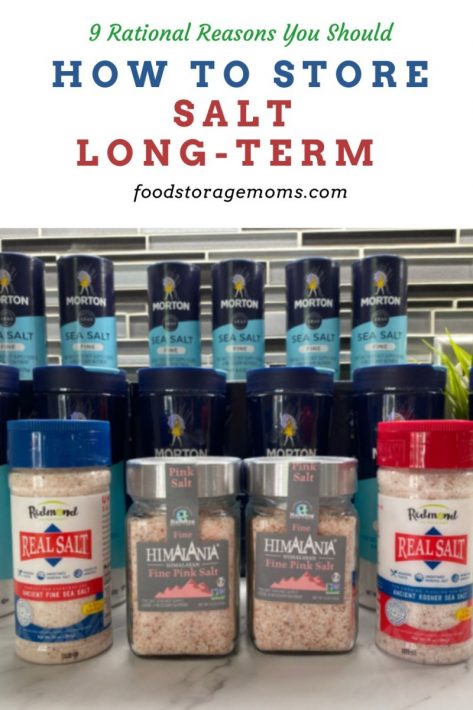
Why Should I Store Salt?
Salt is a versatile and essential ingredient in any kitchen, but it can also have several other uses around the house. Here are just a few reasons why you should always store salt in your pantry or other appropriate location:
1. Great for Cleaning
First of all, salt is great for cleaning. A sprinkle of salt on a damp sponge can help remove stubborn stains from countertops and sinks. You can also use salt to clean delicate items like china and crystal. Just make sure to rinse well afterward.
2. Salt Has Many Health Benefits
Salt is also good for your health. It can help regulate blood pressure, improve circulation, and prevent muscle cramps. In addition, salt can be used as a natural laxative and help relieve congestion. Too much salt can be harmful, so before you change your salt intake to any degree, check with your health professional for guidance.
3. An Essential Survival Item
Salt is an essential item for survival. Salt can purify water during a power outage or other emergency. It can also be used to preserve food. How To Purify Water With Salt
4. Food Preservation
Salt can be used to preserve food. When added to the meat in the right proportions, it can help prevent spoilage and keep it fresh for a longer period. Salt can also be used to pickle vegetables. This preservation method is not only practical, but it also adds a delicious flavor to the vegetables.
5. It Deters Pests
Salt can also be used to deter pests. Sprinkling salt around doorways and windowsills can help keep ants and other insects out of your home.
6. Can Be Used For First Aid
Salt can be used for first aid purposes. For example, if you get a cut or burn, applying a little salt to the area can help clean the wound and speed up healing. When doing so, the wound can be somewhat painful, so be careful not to apply too much.
7. Flavor Enhancement
Of course, flavor enhancement is one of the most essential uses for salt. A little salt can go a long way in bringing out the flavor of food. So, if you want to add extra flavor to your meals, keep salt on hand.
8. Salt Can Be Used to Clear Ice
Salt is convenient when you need to clear some ice buildup on your sidewalk or driveway. Of course, you aren’t using the salt you’d use in a meal recipe for human consumption. Salt used to clear ice is more coarse, often referred to as rock salt. Again, using it often and in large amounts can adversely affect the cement, so clear off the bulk rock salt as appropriate and try not to get too much on your lawn. Salt for this purpose doesn’t require the strict storage issues addressed below.
9. Salt Is A Necessary Part Of Soft Water Systems
For those who like soft water or need it for sensitive skin treatment, having coarse or pelletized salt available for your tank is essential. Of course, salt for your softener is similar to the salt used to clear ice, so you wouldn’t have to worry about its storage like household salt.
How to Store Salt Long-Term
Now that we’ve discussed some reasons you should store salt let’s talk about how to do it. Here are a few tips for storing salt long-term:
Store Salt in a Cool, Dry Location
One of the most important things to remember when storing salt is to keep it in a cool, dry place. Salt can absorb moisture from the air, making it clumpy and hard to use. So, store your salt in an airtight container in a cool, dry place.
Choose the Right Container
When storing salt long-term, choosing the right container—glass or any airtight container is essential. You can also find 5-gallon buckets with Gamma Lids salt storage containers designed to keep salt dry. I store salt containers inside 5-gallon buckets with Gamma Lids.
If the salt you’re storing is for use in cooking, make sure the plastic containers are food-safe like other food storage containers. I like to keep my “recipe salt” in their original plastic bags until they’re opened for usage (see picture below). Glass container storage is fine, but the glass is prone to breakage, so be cautious when handling the containers.
It’s suggested that you don’t store your salt in metal containers. Any moisture can cause those containers to rust and put unwanted chemicals in the salt.
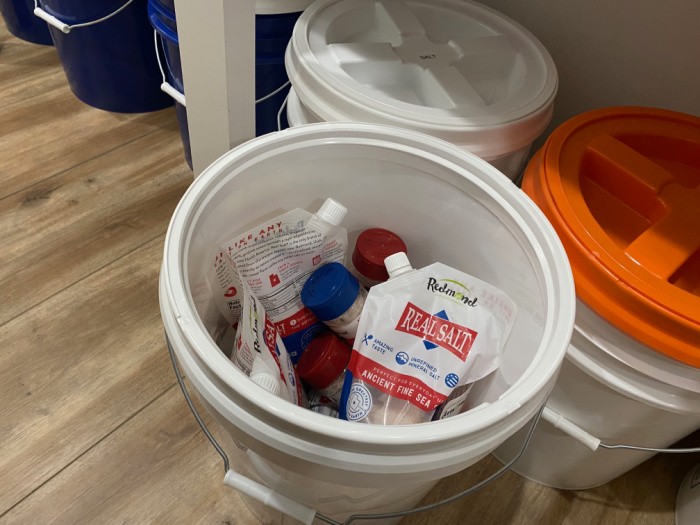
Know When to Replace
Even using the best storage methods, salt can eventually go bad if it has picked up too much moisture and becomes like brick clumps. Yes, you can scrape it, it will take patience. If your salt looks discolored, it’s time to replace it.
How to Store Salt In Bulk
If you want to store salt in bulk for a long time, there are a few things you need to keep in mind. First, make sure to store your salt in an airtight container. You can find special food-grade containers designed for storing bulk items.
Be sure to label your container with the date to know when the salt was packaged. Salt can last several years when stored properly, but it’s always best to err on caution and use it within a year or two. I have five-year-old buckets of salt, and it’s still good, so it’s a personal preference.
Another important thing to remember is to keep your bulk salt in a cool, dry place. A cool basement or root cellar is ideal. Keep it in an airtight container so it doesn’t absorb moisture from the air. Salt that has been treated with iodine and other additives can lose the benefits of those add ons if the salt is subject to moisture or too much light.
Morton Salt Shelf-Life Guide and Cargill Salt Information
How Many Salts Should I Store?
Salt storage amounts vary depending on who you ask. However, most experts recommend 3 pounds of salt per person per year for most household uses, like meal preparation. I find this a low amount and recommend 10 pounds per person annually. Please consider the following:
- The American Heart Association recommends that Americans consume no more than 2,300 mg of sodium per day, about one teaspoon of salt. The average American consumes about 3,400 mg of sodium daily, about 1½ teaspoons of salt. Less than 1% of the population is on a low-sodium diet. That said, I still recommend 10 pounds per person yearly because having extra never hurts.
- According to their studies, Bringham Young University recommends 8 pounds of salt per person per year for long-term storage.
- The Nutrition Facts on the containers of each type of salt list the recommended serving size as 1/4 teaspoon and the sodium content as 590 mg per serving. This means that each teaspoon of salt contains 2,360 mg of sodium. If you have a family of four, I recommend 40 pounds of salt for long-term storage.
How Long Will Salt Last in Long-Term Storage?
Pure salt without additives will last indefinitely. However, sodium chloride is a stable compound that will lose potency or flavor benefits over time.
Pure salts, such as sea salt, Pink Himalayan salt, and canning salt, can last virtually forever if stored correctly. However, salts like iodized salt have a shorter shelf life due to additives.
Best Salts to Stock
There are many types of salt, but not all of them are ideal for long-term storage. Here are some of the best salts to stockpile for long-term storage:
- Sea salt: Sea salt is unrefined and has a high mineral content. It’s also less likely to clump than other types of salt and can be stored indefinitely.
- Pink Himalayan salt: This salt is unrefined and has a high mineral content. It’s also less likely to clump than other types of salt and can be stored indefinitely.
- Canning salt: Canning salt is pure sodium chloride with no additives. It’s perfect for pickling and canning because it doesn’t contain any impurities that can affect the taste or color of food. It can be stored indefinitely.
- Kosher salt: Kosher salt is pure sodium chloride with no additives. It’s used in koshering meat because it doesn’t contain any impurities that can affect the taste or color of food. It can be stored indefinitely.
- Iodized salt: Iodized salt is a table salt with iodine added. This is important for people living where iodine is not naturally found in the water supply. According to Morton, iodized table salt has a 5-year shelf life due to potassium iodide, which is part of its makeup.
What Are the Symptoms of Iodine Deficiency?
We all need daily doses of sodium. You can lose sodium through your sweat, so that’s why many athletes, like runners, take salt tablets before or during competition.
Iodine is an essential mineral we need for proper nutrition. Some locations and cultures don’t get enough iodine since it’s not found naturally in the soil or their diets don’t support enough iodine. That is particularly true of cultures that shy away from seafood or follow strict vegetarian or vegan diets.
Iodine deficiency symptoms include swelling in your neck, unexpected weight gain, fatigue and general weakness, hair loss, dry and flaky skin, changes in normal heart rate, tend to feel cold, challenges during pregnancy, and trouble learning and remembering things. Your thyroid relies on iodine to generate the hormones we all need to function.
If you eat iodized salt you shouldn’t have to worry about iodine deficiency.
More About Salt Storage
- 12 Unusual Uses For Salt
- Salt: Everything You Need to Know
- 15 Reasons Why I Store Epsom Salts
- 5 Interesting Facts About Himalayan Salt
Final Word
Storing salt long-term is a great way to be prepared for an emergency. Salt is an essential item that can be used for many things, such as preserving food, making saline solutions for wounds, and more.
Remember to store salt in an airtight container in a cool, dry place. I also recommend storing 3-10 pounds of salt per person per year. If you want your salt to last indefinitely, make sure to choose pure salt without any additives.
What type of salt do you store? Let me know in the comments below! May God Bless this world, Linda

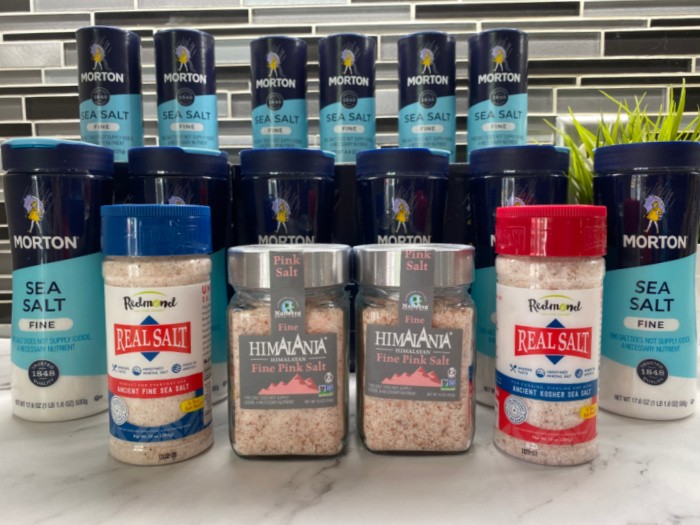

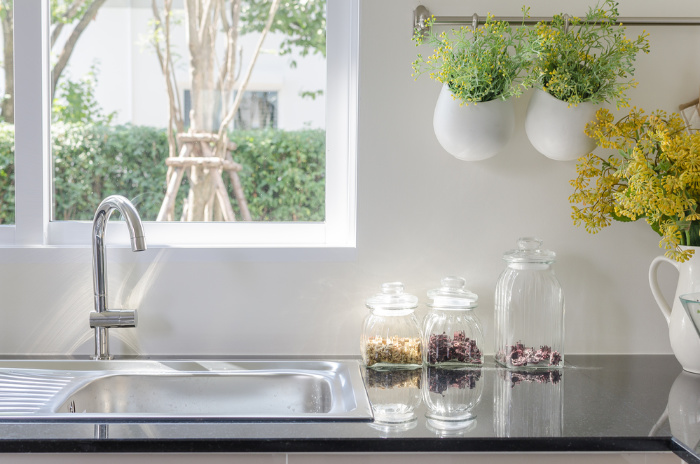
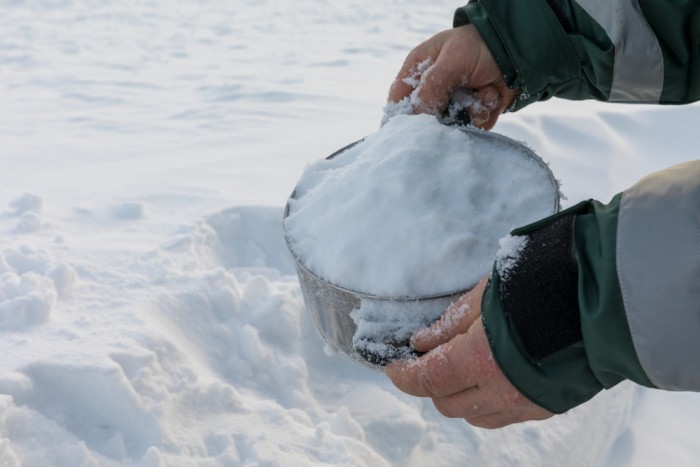



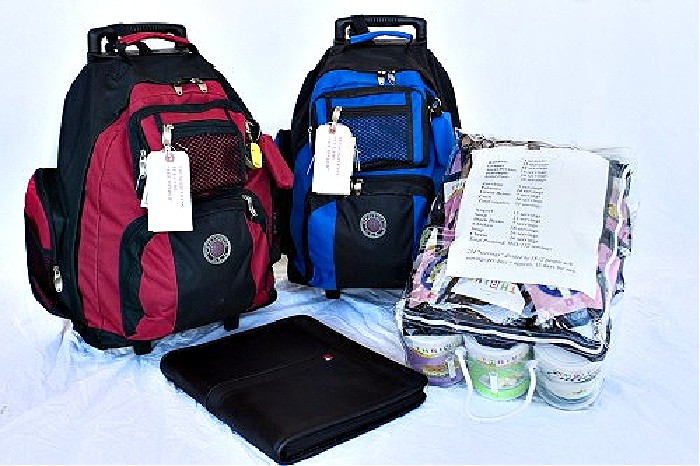













Linda,
Great post as usual. We have a little over 100 pounds of salt, both iodized and sea salt, stored in small four to five pound vacuum sealed packages. Needless to say, we will be using the iodized first and keeping the sea salt for longer term storage if needed.
Hi Harry, thank you for your kind words, my friend. I want to make it easy for people to stock up. So many people make it harder than it needs to be. Good job on the 100 pounds of salt. Linda
I don’t have enough salt stored. We don’t use a lot of salt though, but I’d rather have too much than not enough.
Hi Deborah, I think this is why I write about what I do. It’s a friendly reminder to stock up on what others may need. Life is good! Linda
I store Mediterranean Sea Salt and Pink salt in Mason jars. I find both keep well in the Mason jars and are easy to store in my pantry.
Hi Pam, I love mason jars! Great reminder! Linda
Thank you, Pam! I have jars, so I will be storing the salt in jars.
Great post. It amazes me how little most of us know about the everyday basic items we use/consume. I started buying more sea and kosher salt recently just for the heck of it. Now I’m glad I did! We are a low-salt bunch, but definitely not salt-free. The iodized stuff may wind up being used more for non-food tasks. Thanks.
Hi Terry, thank you for your kind words. It’s nice to be reminded of stocking up on things we need. Life is good when we are prepared! Linda
Health issues prevent us from using too much salt but I still use it. Some recipes require it so I have some (rock hard!) containers in our basement which probably need to be replaced. When I BBQ steak, we use Smoked Applewood salt that we had first tried on a cruise. It’s THE most amazing flavor to filet mignon. I love your articles which tickle the brain on what I need to bone up on for our food storage!
Oh, Linda, I finally got part of the basement cleaned out – I took your advice and did just one section. It still took me several hours but now all my medicines, toiletries, first aid stuff, etc., is all up-to-day, reorganized and looking pretty on the shelf! I dread, simply dread, the next section tho. It’s all my canning supplies, household goods, and horrors of all horrors, the holiday decorations section! But, one step at a time. At least I have aisles I can walk through now.
Hi Robbie, oh I need to find that Smoked Applewood Salt!! That sounds awesome! It’s really fun to be able to see what we have and walk through the aisles again. It’s one section at a time. It doesn’t have to be done all at once. The holiday decorations, I hear you on that one. I had to let go of so many to move to our smaller home. It actually feels good. I gave all the Christmas decorations to two granddaughters, they were thrilled. I love the Christmas tree with just lights, it’s easy to put up and take down. I love it! It’s all about simplifying my life. It feels great! Linda
Linda, talks about live and learn. I had no idea salt could go bad. I mean, yes, I knew it could absorb humidity and get hard as a rock but wow! I’m checking dates on all my iodized salt now. I put desiccant pack in my salt storage containers–not in with the alt itself, but into the buckets my bags of salt go into.
Great article about an important subject.
HI Ray, thank you for your kind words, my friend. It’s all about stocking, rotating, and tossing. Linda
Only non iodized salt will preserve meat properly
Hi Matt, I have only made hamburger jerky and it had to be refrigerated or frozen after making it. I have only used, Tender Quick (Home Meat Cure Salt). Good to know. Linda
Sea salt is very easy to do yourself by evaporating the seawater in able to have pure sea salt left. I used to do this with my nieces and nephews every summer when I would take them to the beach. They loved doing this and had such pride in the salt that they would take it home to use until the next summer when we would do it again. It became a tradition that they looked forward to with their Auntie (that’s me 😉 ) every summer. In all honesty, I initially showed them how when I was a very young child we were so poor that we when would be at the backwaters of the ocean shrimpin and crabin for our own subsistence needs we would also use that opportunity to collect seawater to later boil down for the salt.
This is a great “prepper family activity” for when vacationing at oceanside locations.
Hi Ravenna, wow, good to know. That would be a good family project like you said. I love it! Linda
My oldest niece, now that she is a parent is doing this with her kids. I love how something that when I was a kid was done due to poverty, but has turned into a family tradition as a way to honor and pass on those time-honored skills. I love getting a small jar of sea salt that my great nieces processed and gave to me as my Christmas gift.
HI Ravenna, oh me too! I love hearing about time-honored skills! Oh, and homemade gifts like that are the best thing ever! Linda
We have a large bucket of salt compliments of our HOA for use on the driveway and steps. I have 10 pounds of iodized salt and 4 pounds of pink Himalayan salt. Prior to reading this article, I thought that was enough. Now I know I have alot of work to do. We do have 4 salt lamps, more for their soft glow, rather than any health benefits. Off to add more salt to my curbside pickup order. Stay safe and healthy everyone.
Hi Chris, the HOA gave you salt? Wow, that’s awesome! Concrete gets slippery, that’s for sure. It’s better to have too much than not enough. Stay safe! Linda
another salt product to stockpile and the reason behind it is to create an animal salt lick >>> in the post-SHTF times without any enforcement of game laws you’ll want time & effort savings way to fill the dinner table – totally illegal and hunter morality absent in normal times a salt block and a water source could be a life saver …..
Hi Illini Warrior, great tip on the animal salt lick, thank you! Linda
Hi Linda:
I know of one salt you did not mention and that is Israel dead sea salt. My son bought it when he was alive and it is a really good salt. I did a search and you can buy it from Israeli products. at (www)israeliproducts.com/spices-and-seasonings. This is the only place I could find that sold Dead sea salt for use in food. Other places have it but it is labeled for using in your bath. One said it was all natural so I assume that it could be used for cooking but it did not say.
Hi Jackie, oh thank you for that tip! I love trying different salt!! Linda
Does Morton mention the shelf life of their non-iodized table salt?
Thanks!
Hi Karl, yes, it’s 5 years, here’s the link where I found the shelf-life. https://www.mortonsalt.com/article/morton-salt-expiration-guide/
Linda
Great. Thanks!!!
Is the shelf life of Cargill Purified Sea Salt with magnesium carbonate no longer indefinite? I had intended it for long-term storage but may alter plans (and storage containers) if the anti-caking agent means it’s no longer a good option for that.
Hi Kat, this is where I looked up the information, Cargill Salt
I hope this helps, Linda
Linda,
I just tried to order Mortons Canning Salt from Amazon and was informed it “can’t be shipped to your location.” Any idea why?
I’ll try to pick more up at a local store today. We do mostly use iodized salt for eating. I use non-iodized salt if I can veggies–though I usually don’t season anything I’m canning (unless it’s pie filling).
Hi Ray, what? Send me the link and I will look for some. I can see Canning and Pickling salt. I can ship some to you if Sam’s Club has it. Let me know what you are looking for. Linda
I posted a reply to Ray that it is available at WalMart and webstaurantstore. For some reason, I guess it got thrown out. Perhaps it did not like me putting in the full URL.
Hi Harry, for some reason I had to “approve the comment”, normally I only have to do that on NEW commenters. Thanks for the links. Linda
The link I clicked on was the one in your article which took me to Amazon where I saw that notice. I’m hitting the store tomorrow (4x points day at Smith’s) so I’ll see if any of our local stores have it. I’m sure I’ve seen both canning and kosher salt here, just mystified why Amazon couldn’t ship it to my location when it was in stock.
Hi. Ray, I changed out that link, that bugs me. I’m so sorry, I love having stuff shipped to me. I stay out of stores whenever I can. Linda
Linda, I usually click on all the links you publish as I’m always looking for good ideas. Also, I know you earn a small commission if I buy something and I’m glad to do that too.
Hii Ray, you are so kind I thank you from the bottom of my heart. This is why I put your book in a post whenever I can. Linda
Ray,
Try https://www.walmart.com/ip/Morton-Salt-Canning-Pickling-Salt-for-Preserving-and-Pickling-4-lb-Box/10318924 or https://www.webstaurantstore.com/morton-4-lb-canning-and-pickling-salt/102SALT11086.html
Hi Harry, Thanks for sharing the links, Linda
Thanks Harry. Just to be on the safe side I ordered some from Walmart, but tomorrow I’ll be looking for more locally.
Hi Ray, good idea, there will be a lot of shortages, I’m trying to write an article about the shortages coming up, there are a lot of them. Linda
It’s also good for keeping ghosts and other spirits out of your house. It’s true! I read about it on FB!!!
Hi Karl, now i have the giggles, thanks for sharing!!!! Linda
Anything I can do to make all of us safer.
Hi Karl, we need it right now! Linda
What? You don’t have any already stored? Tsk. Tsk. Tsk. That’s a shame. Good luck.
Hi Karl, I meant we need to stay safe. Linda
I know. Just my weird sense of humor. Have a great rest of your day.
Hi Karl, I love your sense of humor, right now we need all we can get to giggle or laugh. Linda
Hi Linda, just wanted to share a tip. I live in an area with moderate to high humidity. So sometimes salt hardens into a rock. Storing in smaller containers with straight sides. Line them with parchment paper that will make it easier to lift out. You can put a zipper bag over it. Like old loaf pans work.When it gets hard, lift it out of the container back into the zipper bag. Take a hammer and use it to break off manageable chunks. Using the fine side of a grater, grind off what you need. Store the rest in the zipper bags. It can also be soaked in water to make a sodium solution. Put it in lined flat pans in the sun or a hot area and let it recrystalize. This makes good coarse salt crystals you can use for cleaning and other uses that aren’t food uses. I also want to stress, to be careful where you use salt out doors or for cleaning flower pots.. salt added to or used on soil, will kill weeds, but not just weeds. The salted soil will not grown anything green for a long time after. One bit of history. Early man, and, up through overseas or camel trains. It was stored in those blocks for later use, was stored in hard blocks until use. Then they broke off what was needed.the crystalline free flowing salt of this current time is a relatively recent creation. The tray drying was used amongs the Indian tribes for centuries. They would make a Summer camp near a salt source (like Great Salt Lake, a salt flat, or an out crop. Get what they needed, re crystallized it and return to Winter Camp, with enough salt for a year or more. Salting was their primary means of preservation. It was also used by Medicine Healers in many remedies, as well as flavor food.
Hi MaryAnn, great tip on how to store salt where you have high humidity. That’s rough for sure. Linda